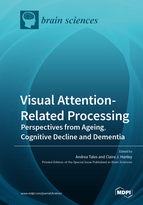Visual Attention-Related Processing: Perspectives from Ageing, Cognitive Decline and Dementia
A special issue of Brain Sciences (ISSN 2076-3425).
Deadline for manuscript submissions: closed (30 June 2020) | Viewed by 29012
Special Issue Editors
Interests: mild cognitive impairment; subjective cognitive impairment; Alzheimer's disease; dementia; ageing; visual attention; methodology; reaction time; intra-individual variability in reaction time
Special Issues, Collections and Topics in MDPI journals
Special Issue Information
Dear Colleagues,
Visual attention is a multi-component process, which is essential for information processing and environmental interactions. Throughout the lifespan, the speed and precision of our ability to respond to visual stimuli deteriorates, in line with changes in brain structure and function. These deficits become progressively more pronounced in subjective cognitive decline, mild cognitive impairment (MCI), and various forms of dementia. In a clinical capacity, MCI and dementia are typically characterised by performance on neuropsychological tests, which are reliant on static measures of executive function (for example, memory and language). However, these methods are likely to underestimate the impact of pathological change on behavior, as indicated by research evidence derived from the use of more dynamic measures, based on the speed of responses. Although executive function is commonly examined in such clinical populations, it represents only the integrity of high-level processing. This is despite recent literature that suggests that low-level, salience-based mechanisms are also significantly impaired, and may provide early indications of emerging pathology. Accordingly, examining the integrity of attention, in its multiple forms, will improve our understanding of a given disease process, help to explain its behavioral effects, and ultimately explain its impact upon everyday life. Using a range of methodological approaches, from cognitive test performance to neuroimaging and brain stimulation, the aim of this Special Issue is to provide an overview of evidence illustrating the integrity of a wide-range of visual attention-related processes. These investigations will target the process of healthy ageing, as compared to the prodromal stages of clinical deficits (SCD, MCI), and various aetiologies of dementia.
Prof. Andrea Tales
Dr. Claire Hanley
Guest Editors
Manuscript Submission Information
Manuscripts should be submitted online at www.mdpi.com by registering and logging in to this website. Once you are registered, click here to go to the submission form. Manuscripts can be submitted until the deadline. All submissions that pass pre-check are peer-reviewed. Accepted papers will be published continuously in the journal (as soon as accepted) and will be listed together on the special issue website. Research articles, review articles as well as short communications are invited. For planned papers, a title and short abstract (about 100 words) can be sent to the Editorial Office for announcement on this website.
Submitted manuscripts should not have been published previously, nor be under consideration for publication elsewhere (except conference proceedings papers). All manuscripts are thoroughly refereed through a single-blind peer-review process. A guide for authors and other relevant information for submission of manuscripts is available on the Instructions for Authors page. Brain Sciences is an international peer-reviewed open access monthly journal published by MDPI.
Please visit the Instructions for Authors page before submitting a manuscript. The Article Processing Charge (APC) for publication in this open access journal is 2200 CHF (Swiss Francs). Submitted papers should be well formatted and use good English. Authors may use MDPI's English editing service prior to publication or during author revisions.
Keywords
- Visual attention;
- Exogenous/endogenous attention;
- Pre-attentive visual processing;
- Attentional shifting/switching/dual-tasking;
- Ageing;
- Cognitive decline/impairment;
- Dementia;
- Cognitive enhancement;
- Brain stimulation;
- Neuroimaging







